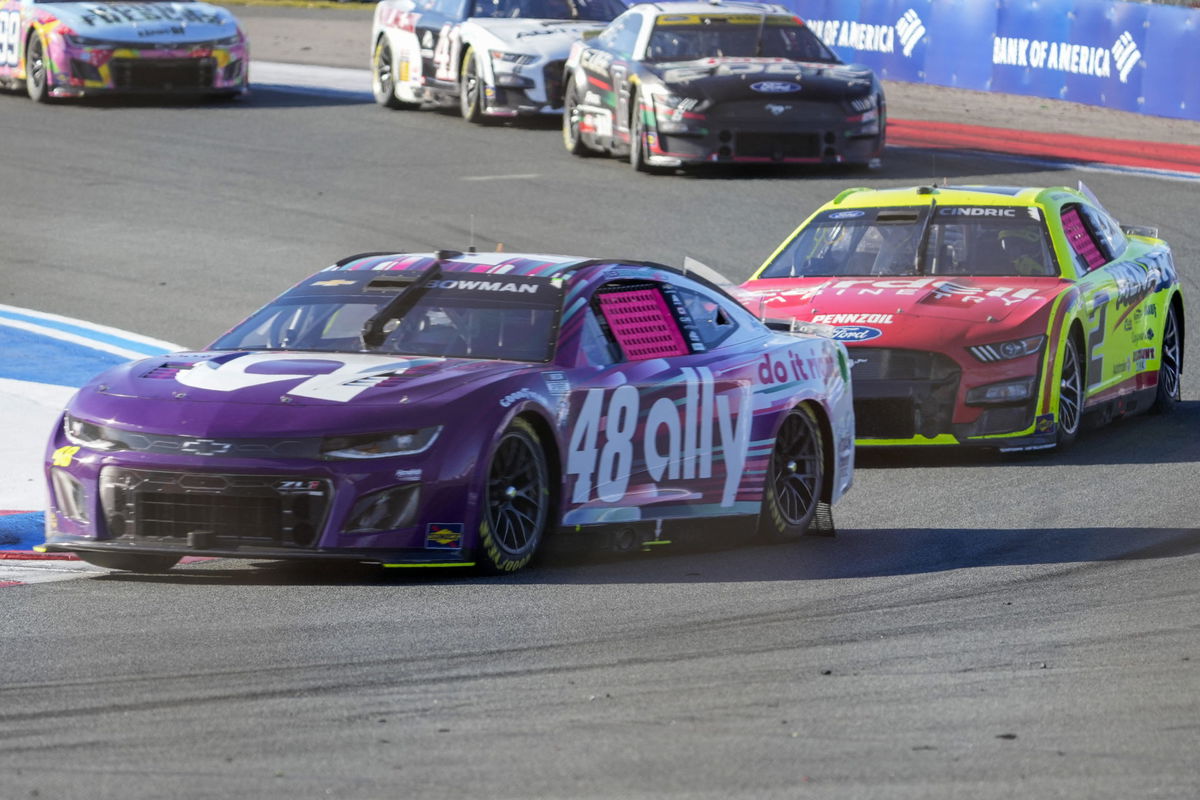
USA Today via Reuters
Oct 8, 2023; Concord, North Carolina, USA; NASCAR Cup Series driver Alex Bowman (48) drives ahead of driver Austin Cindric (2) at turn four during the Bank of America Roval 400 at Charlotte Motor Speedway Road Course. Mandatory Credit: Jim Dedmon-USA TODAY Sports

USA Today via Reuters
Oct 8, 2023; Concord, North Carolina, USA; NASCAR Cup Series driver Alex Bowman (48) drives ahead of driver Austin Cindric (2) at turn four during the Bank of America Roval 400 at Charlotte Motor Speedway Road Course. Mandatory Credit: Jim Dedmon-USA TODAY Sports
While the whole NASCAR fanbase is stoked to see the action resume on February 4th with the pre-season race at L.A. Coliseum, the short track package is still under scrutiny. Drivers racing each other in close quarters at smaller half-a-mile venues like Bristol, and Martinsville Speedway have always been a treat for the fans. However, with the introduction of the revolutionary Next-Gen cars that have now become sluggish in close quarters, the organization is doing its best to get its once sublime and popular product great again.
Watch What’s Trending Now!
While the fans and the sanctioning body recognized the major flaw, it looks like the seventh-generation cars are slowly yet steadily inching toward the solution despite NASCAR not heeding drivers’ demand for more horsepower. Let’s see how NASCAR is chipping away at the issue without compromising the longevity of its race machines.
ADVERTISEMENT
Next-gen cars are a step in the right direction for improving short-track racing
Ask any ardent NASCAR fan what their favorite race is; the answer most probably would’ve been the short track race held in Bristol or Martinsville. However, with the cars becoming more identical with similar specs and dynamics, passing became a hard nut to crack for drivers, especially on half-mile tracks. Drivers like JGR veteran Denny Hamlin and 2-time Daytona winner Dale Earnhardt Jr have often voiced their opinions about the need for increasing power figures. Even the King, Richard Petty, was vocal about the issue, standing his ground and urging NASCAR to churn out more HP instead of de-tuning the car and cutting down on the power.
Needless to say, not only did the governing body stuff this demand but instead went ahead with tweaking the aero package. The Next Gen cars will feature a large floor piece underneath the car, which will be dramatically reduced this season on short tracks and road courses. With less downforce created by the undertray, drivers, in theory, should be able to slide the rear of the car, thus giving it more maneuverability on the racetrack, which in turn will give way for more passes, which many fans equate to better racing.

USA Today via Reuters
Aug 26, 2023; Daytona Beach, Florida, USA; NASCAR Cup Series driver Austin Cindric (2) races during the Coke Zero Sugar 400 at Daytona International Speedway. Mandatory Credit: Mike Watters-USA TODAY Sports
While tire wear also contributes to the issue, NASCAR’s decision not to bump up the power in its machines will certainly keep the cars more reliable, taking away the risk of a catastrophic engine failure and thus keeping the budget at a minimum. Moreover, even though, the recent car testing at Phoenix has improved the car’s aerodynamics considerably, it is still rough around the edges.
ADVERTISEMENT
WATCH THIS STORY: NASCAR to test its first electric compact utility vehicle at the Clash in Los Angeles
ADVERTISEMENT
According to industry experts like Richard Johns, a mechanical engineer who leads NASCAR’s performance team at Ford, the steps are in the right direction for a problem that doesn’t have an exact solution. He said, “It’ll probably take another iteration or two to really get back to the racing we saw with the old Gen 6 car at some of those tracks.”
Top Stories
Greg Biffle’s $4M Worth Prized Possession Still Without a Buyer Leaves NASCAR Fans Heartbroken

Denny Hamlin Offers First Words Since Losing Beloved Father in Anniversary Fire

Fox Broadcaster Pens Heartfelt Message as Veteran Announcer Quits NASCAR

NASCAR World Mourns as Former Watkins Glen President Michael Printup Passes Away at 60

“This Is Not Racing”: Growing Outrage Erupts Over How Kids Are Being Taught to Win at Any Cost in Modern Motorsports

“I don’t know how to fix this yet”- NASCAR official gets candid about the major issue
Despite the massive changes in the aero packages, the new-generation car is still as effective as the sixth-generation cars in general, especially in close-quarter scenarios. Even NASCAR’s Vice President of Vehicle Design aligns with this notion; he even goes to the extent of putting it bluntly out there, mentioning that there still isn’t a clear-cut solution to the problem.
ADVERTISEMENT
According to The Athletic.com, he said, “Our stance is I’m not going to stand up there and say, I know how to fix this, I don’t know how to fix this yet. I’m saying I’m willing to go investigate where we think our issues are and then make some honest accounts of where we’re at and what we can go work on.”
Even though he identifies the problem and is very much aware of the situation, he too is pretty convinced and optimistic about finding the light at the end of the tunnel, saying, “It’s only a problem. Problems have solutions.”
ADVERTISEMENT
ADVERTISEMENT
ADVERTISEMENT
ADVERTISEMENT

